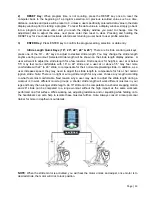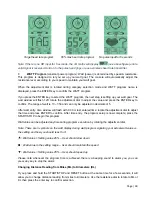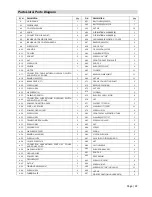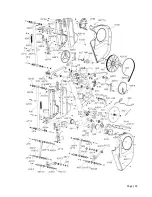
Page
|
19
Monitoring Your Heart Rate
In order to obtain the greatest cardiovascular benefits from your exercise workout, it is important to
work within your target heart rate zone. The American Heart Association defines this target as 60%-
85% percent of your maximum heart rate.
Your maximum heart rate may be roughly calculated by subtracting your age from 220. Your maximum
heart rate and aerobic capacity naturally decreases as you age. This will vary from one person to
another. Use this number to find your approximate effective target zone. It is most effective to train at
your target heart rate between 60% and 85% of your maximum heart rate; referred to as “Training
Zone”. In order to get the most accurate reading, it is recommended to enter your age before your
workout.
Before beginning your workout, check your normal resting heart rate. Place your fingers lightly against
your neck or against your wrist over the main artery. After finding your pulse, count the number of beats
in 10 seconds. Multiply the number of beats by six to determine your resting pulse rate per minute. We
recommend taking your heart rate at these times; at rest, after warming up, during your workout and
two minutes into your cool down, to accurately track your progress as it relates to better fitness.
During your first several months of exercising, the AHA recommends aiming for the lower part of the
target heart rate zone-60%, then gradually progressing up to 75%. According to the AHA, exercising
above 85% of your maximum heart rate may be too strenuous unless you are in top physical condition.
Exercising below 60% of your maximum will result in minimal cardiovascular conditioning.
Check your pulse recovery rate – If your pulse is over 100bpm five minutes after you stop exercising, or
if it’s higher than normal the morning after exercising, your exertion may have been too strenuous for
your current fitness level. Rest and reduce the intensity level of the next exercise.
Fitness Safety: The Heart Rate chart indicates average heart rate zones for different ages. A variety of
different factors (including medication, emotional state, temperature and other conditions) can affect the
target heart rate zone that is best for you. Your physician or health care professional can help you
determine the exercise intensity that is appropriate for your age and condition.
Содержание VST-V8
Страница 1: ...User s Product Manual LifeCORE VST V8 Variable Stride Trainer...
Страница 6: ...Page 5...
Страница 25: ...Page 24...
Страница 26: ...Page 25...









































